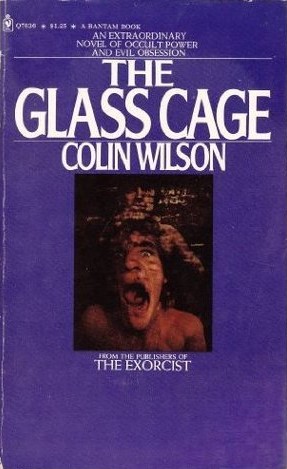By COLIN WILSON (Bantam; 1966/73)
Such was the power of THE EXORCIST by William Peter Blatty that Bantam’s honchos dredged up this 1966 novel by the controversial British occultist Colin Wilson and republished it in 1973, with cover art that directly replicated THE EXORCIST’s famous paperback design and a “From the Publishers of THE EXORCIST” signifier (just in case we didn’t notice the resemblance). An odd strategy, as this “unconventional detective story” (so claims the title page) has very little in common with Blatty’s novel.
THE GLASS CAGE’s characterizations are stronger than those of most Wilson novels, and no wonder: the protagonist, a highly reclusive William Blake scholar named Damon Reade, is very much a self-insert, spouting Wilsonian soliloquies about psychic energy and the nature of intelligence (specifically Wilson’s contention that most people only use a tiny portion of their intellectual potential). Reade’s self-imposed exile is ended when he’s contacted by the police about the discovery of several mutilated women’s bodies accompanied by Blake quotations scrawled on nearby walls.
Reade’s investigations lead him to George Sundheim, the son of a Blake scholar who died in an insane asylum. Sundheim lives in a flat located above a butcher’s shop and adjacent to a slaughterhouse, has a prodigious appetite and, despite a deceptively pleasant demeanor that initially disarms Reade, has disturbingly kinky proclivities. Hence, he shows every sign of being—and indeed is—the killer.
A supernatural angle is introduced in a brief interaction Reade has with an apparently psychic colleague, as is a perverse sexual component in Reade’s interactions with Sarah, the young niece of a close friend who in a too-quickly-discarded subplot reveals some unsettling details about her relationship with her guardian. Neither of those aspects are taken very far, although Wilson further explored them, and the concept of a voracious killer, in subsequent novels. THE GLASS CAGE, then, is best viewed as a warm-up for bigger and better things.
Those better things, incidentally, would seem to include an iconic 1981 novel that concerned a William Blake obsessed killer. Whether Thomas Harris had THE GLASS CAGE in mind when he wrote RED DRAGON is unknown, but the similarities between the two books certainly go a lot deeper than the EXORCIST connection, and are impossible to ignore.

